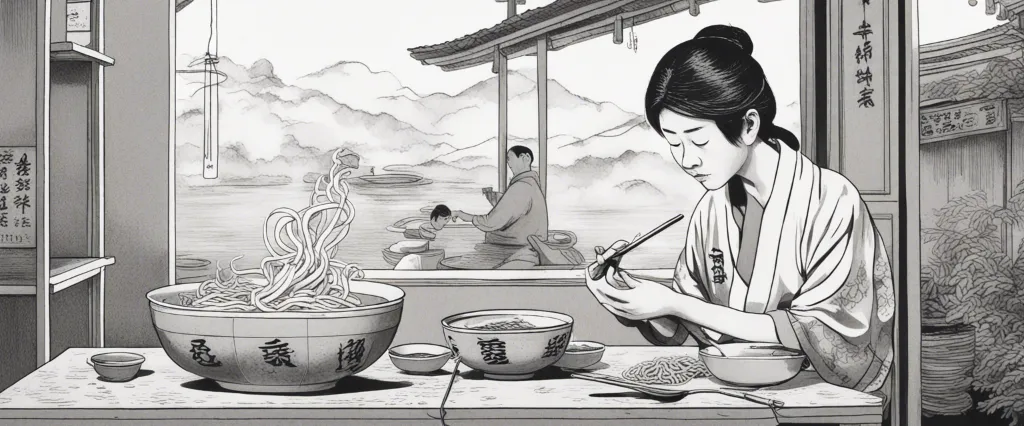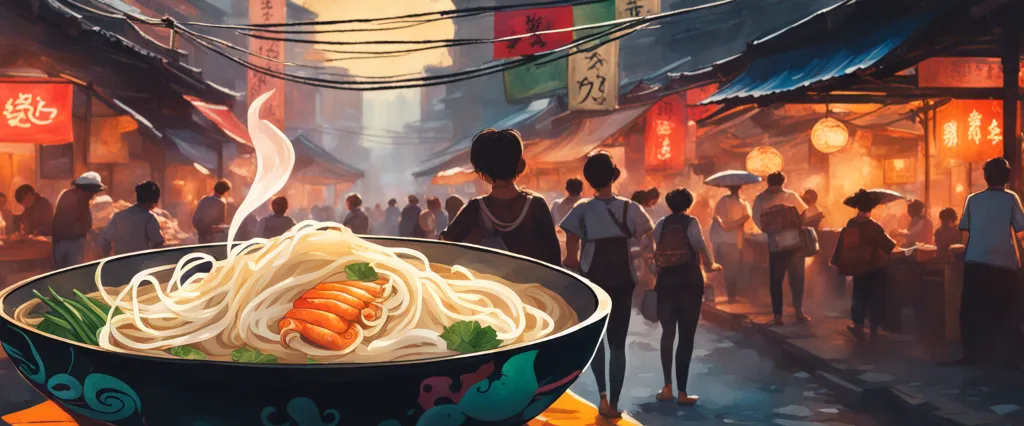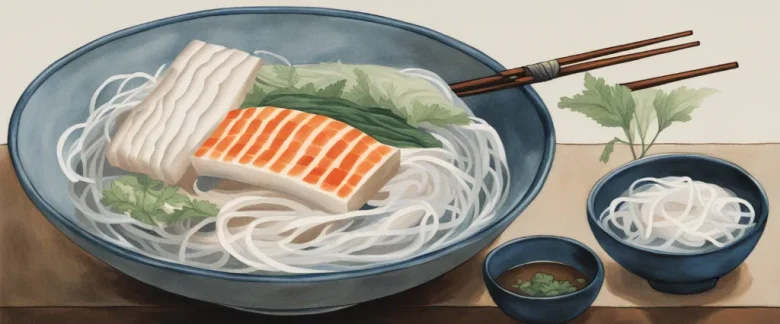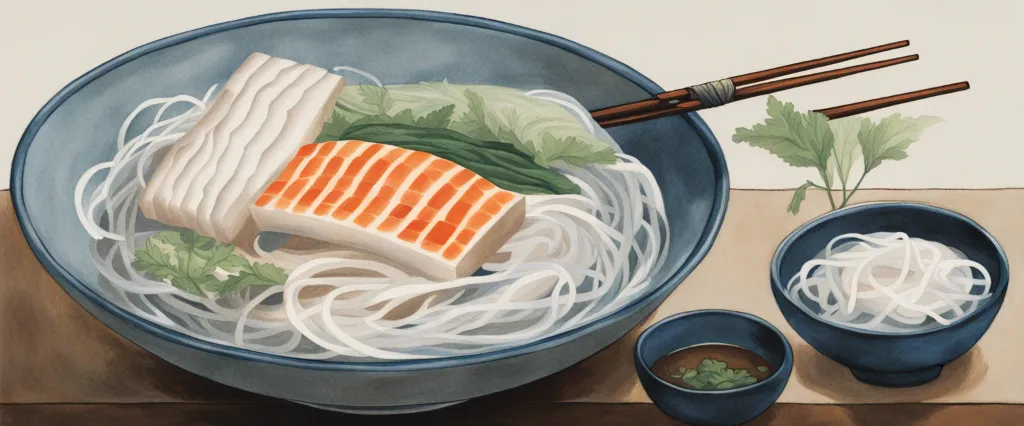In Rice, Noodle, Fish, Matt Goulding takes readers on an enticing culinary journey across Japan, immersing us in the rich tapestry of its food culture. Recognized for his remarkable ability to seamlessly blend storytelling with gastronomy, Goulding introduces us to the enchanting world of Japanese cuisine, unearthing the secrets of its renowned ramen shops, sushi bars, and izakayas. As a New York Times bestselling author and the co-founder of Roads & Kingdoms, an award-winning travel and food website, Goulding is no stranger to exploring the intersection of culture, travel, and culinary experiences. Through his captivating storytelling and unparalleled depth of knowledge, he offers a unique perspective on Japan’s vibrant food scene, uncovering hidden gems and inviting us to savor every delectable bite along the way.
Chapter 1: Introduction to Japanese Cuisine
Chapter 1: Introduction to Japanese Cuisine of the book Rice Noodle Fish by Matt Goulding provides an engaging overview of the rich culinary traditions found in Japan. The chapter begins by highlighting Japan’s unique and ancient culinary heritage, as well as the key principles that define Japanese cooking.
Goulding introduces the concept of “The Way,” a philosophy that influences every aspect of Japanese cuisine. “The Way” emphasizes the pursuit of perfection through discipline and attention to detail, which extends to the intricate and delicate process of preparing Japanese dishes. Goulding underscores the importance of craftsmanship and respect for ingredients in Japanese cooking, making it clear that every element must be handled with utmost care.
The chapter also explores the role of seasonality in Japanese cuisine. Japanese people have deep connections to nature, and this is reflected in their approach to cooking. Goulding explains how each season brings its own unique ingredients and flavors, and the importance of adapting recipes accordingly to fully appreciate the natural bounty available.
Furthermore, the chapter delves into the art of sushi-making and the different types of sushi found in Japan. The detailed descriptions and explanations help readers understand the significance of each type, the ingredients used, and the mastery required to create these delectable morsels.
Overall, Chapter 1 serves as a captivating introduction to Japanese cuisine. It highlights the distinct cultural values that shape the food, emphasizing the importance of tradition, quality, and harmony with nature. Goulding’s engaging writing style immerses readers in the world of Japanese cooking and provokes a deep appreciation for the exquisite flavors and meticulous craftsmanship that define this culinary tradition.
Chapter 2: Tokyo: The Culinary Capital
In Chapter 2 of “Rice Noodle Fish” by Matt Goulding, titled “Tokyo: The Culinary Capital,” the author takes the reader on a gastronomic tour of one of the world’s most vibrant food cities. Goulding explores the diverse range of culinary offerings in Tokyo, showcasing its unparalleled dedication to food culture and attention to detail.
The chapter begins with the author’s introduction to the concept of “shokunin,” the Japanese term for an artisan who is dedicated to their craft, striving for mastery and perfection. This mindset is deeply ingrained in Tokyo’s food scene, where chefs devote their lives to perfecting a single dish, resulting in extraordinary flavors and techniques.
Goulding then delves into the rich array of dining experiences available in Tokyo, ranging from high-end sushi temples to humble street food stalls. He shines a spotlight on Tsukiji Market, the world’s largest seafood market, where fresh and sustainable ingredients take center stage. From savoring succulent sashimi to indulging in delicate tempura, the author emphasizes how Tokyo offers an edible paradise for seafood enthusiasts.
Venturing into the Yanaka neighborhood, Goulding explores the city’s deep connection to traditional food culture. He visits small family-run eateries and izakayas, where local charm and old-world recipes combine to create a nostalgic culinary experience.
In Tokyo, even the simplest dishes receive the utmost care and attention. The author describes his encounters with steaming bowls of ramen, thoughtfully assembled yakitori, and perfectly crafted bowls of tonkatsu. Through his descriptions, he conveys Tokyo’s dedication to preserving and innovating upon classic Japanese cuisine.
Overall, Chapter 2 of “Rice Noodle Fish” highlights Tokyo as the culinary capital it truly is—a city where food is treated as an art form, and where the pursuit of gastronomic perfection is a way of life.
Chapter 3: Hokkaido: The Land of Seafood
Chapter 3 of the book Rice Noodle Fish by Matt Goulding explores Hokkaido, a northern island of Japan known as “The Land of Seafood.” The chapter delves into the rich and diverse fishing culture of Hokkaido, uncovering unique culinary traditions and experiences.
Goulding takes readers on a journey through the bustling fish markets of Hokkaido’s capital city, Sapporo. These markets teem with an array of fresh seafood, from giant king crabs to succulent uni (sea urchin). He describes the energy and excitement as locals and visitors gather to sample the catch of the day, creating a vibrant and lively atmosphere.
The author also ventures into the countryside, where he encounters smaller fishing villages, each with its own distinct seafood specialties. In these remote communities, the emphasis is on preserving traditional fishing methods and maintaining a sustainable relationship with the sea. Goulding highlights the harmonious connection between the fishermen and their surroundings, emphasizing their unwavering respect and dedication to their craft.
Throughout the chapter, Goulding exposes readers to a wide range of seafood dishes unique to Hokkaido. He delves into the delicate art of preparing sashimi, tastefully showcasing the intricacies of Hokkaido’s renowned seafood cuisine. The author also explores the island’s rich marine ecosystem, describing the bounty of seafood that Hokkaido has to offer.
In summary, Chapter 3 of Rice Noodle Fish immerses readers in Hokkaido’s seafood culture, from bustling city fish markets to remote fishing villages. Goulding’s exploration of the island’s vibrant fishing industry and the unique dishes it produces offers a captivating insight into Hokkaido’s exceptional relationship with the sea and its unparalleled seafood offerings.
Chapter 4: Kyoto: The Heart of Tradition

Chapter 4 of “Rice Noodle Fish” by Matt Goulding is titled “Kyoto: The Heart of Tradition.” In this chapter, Goulding explores the history, culture, and culinary delights of Kyoto, Japan’s ancient capital city.
Goulding begins by describing Kyoto as a city trapped in time, where traditional Japanese customs and aesthetics are still deeply rooted. He highlights the city’s abundance of ancient temples, meticulously maintained gardens, and elegant geisha district. The author emphasizes that these traditional elements continue to shape Kyoto’s identity and draw tourists from around the world.
Highlighting Kyoto’s rich culinary heritage, Goulding delves into the world of kaiseki, a traditional multi-course dining experience that focuses on seasonal ingredients and artistic presentation. He introduces the renowned kaiseki chef, Yoshihiro Murata, whose family has been preserving this culinary legacy for generations. Murata’s restaurant, Kikunoi, serves as a perfect example of the meticulous craftsmanship that defines the kaiseki experience.
Moving on to street food, the author explores Kyoto’s famous Nishiki Market, known as the “Kitchen of Kyoto.” Here, visitors can sample a wide range of local delicacies, such as tofu donuts, pickled vegetables, and freshly grilled skewers of yakitori.
Goulding also dives into the tradition of matcha, the powdered green tea that is an integral part of Kyoto’s tea ceremonies. He showcases how the beverage has evolved, from traditional preparation to modern innovations, like matcha-flavored gelato and matcha-infused cocktails.
In this chapter, Goulding captures both the time-honored traditions and the dynamic food scene of Kyoto. He paints a vivid picture of a city that successfully balances the preservation of its cultural heritage with its embrace of innovation.
Chapter 5: Osaka: The City of Street Food
Chapter 5 of Rice Noodle Fish by Matt Goulding explores the vibrant culinary scene of Osaka, known as “The City of Street Food.” The chapter takes readers on a gastronomic journey through the bustling streets of this Japanese city, introducing them to its diverse range of food stalls, markets, and restaurants.
Goulding begins by highlighting Osaka’s reputation as a haven for food lovers, with its rich culinary history and emphasis on bold and hearty flavors. He describes the city as a place where food culture is ingrained in the daily lives of its residents, who take immense pride in their local cuisine.
The author delves into the concept of “kuidaore,” which translates to “eat till you drop,” a phrase that perfectly encapsulates the city’s approach to dining. Goulding then leads readers through the iconic food districts, such as Dotonbori and Shinsekai, and explores the different types of street food available, from takoyaki (battered octopus balls) and okonomiyaki (savory pancakes) to kushikatsu (deep-fried skewers) and yakitori (grilled chicken skewers).
The chapter also delves into the history and craftsmanship behind some of Osaka’s culinary specialties. For example, Goulding details the meticulous process of making traditional udon noodles and delves into the world of a Michelin-starred sushi chef who combines tradition with innovation.
Throughout the chapter, Goulding’s vivid descriptions and personal experiences immerse readers in the sights, sounds, and flavors of Osaka. Along the way, he also sheds light on the local food culture, including the importance of street food festivals, the role of the izakaya (Japanese pub), and the dynamic relationship between chefs and their loyal customers.
In conclusion, Chapter 5 of Rice Noodle Fish captures the essence of Osaka’s food scene, showcasing the city’s love for street food, its culinary heritage, and the vibrant energy that defines its unique culinary culture.
Chapter 6: Hiroshima and Miyajima: Beyond Sushi
Chapter 6 of Rice Noodle Fish by Matt Goulding, titled “Hiroshima and Miyajima: Beyond Sushi,” delves into the unique culinary and cultural experiences found in the Japanese cities of Hiroshima and Miyajima.
The chapter begins in Hiroshima, a city infamously associated with the atomic bomb. Goulding explores the local vibe and highlights the resilience of its people, who have turned Hiroshima into a vibrant food destination. The chapter explores the city’s deep love for its signature dish, Okonomiyaki, a savory pancake that can be customized with a variety of ingredients. Readers are introduced to Okonomimura, a multi-story building solely dedicated to serving this popular dish, providing visitors with a true taste of the city.
From Hiroshima, the narrative moves to the nearby island of Miyajima, famous for the iconic floating torii gate. The author describes the beauty of this sacred island and its symbol, Itsukushima Shrine. Visitors are encouraged to indulge in local street food, such as Momiji Manju, a maple-leaf-shaped pastry filled with sweet red bean paste. Additionally, the chapter explores Miyajima’s seafood culture, including oysters and the succulent anago eel, which is often grilled or served in rice bowls.
Goulding dives into the tradition of Shojin Ryori, a vegetarian Buddhist cuisine that originated in Miyajima. He visits an exclusive Buddhist temple and experiences a meticulously prepared and beautifully presented meal, emphasizing the connection between food and nature in Japanese culture.
Overall, this chapter offers a captivating exploration of Hiroshima’s resilience and its unique culinary offerings, as well as the serene beauty and cultural significance of Miyajima’s island cuisine. It provides a deeper understanding of Japanese food culture, and the importance of embracing local flavors and traditions.
Chapter 7: Kyushu: The Land of Ramen and Sake
Chapter 7 of the book “Rice Noodle Fish” by Matt Goulding takes readers to Kyushu, an island in southwestern Japan known for its rich culinary traditions, particularly its ramen and sake. This chapter delves deep into the cultural significance of these culinary delights and explores the fascinating stories behind some of the region’s most iconic dishes.
Goulding begins by highlighting Kyushu’s diverse landscape, which ranges from volcanic peaks to coastal plains, influencing the unique flavors found in the local cuisine. The chapter explores the city of Fukuoka, renowned as the birthplace of tonkotsu ramen characterized by its creamy pork bone broth. Goulding delves into the meticulous process of making tonkotsu broth, revealing the hours of simmering and constant monitoring required to achieve the perfect balance of flavor.
Moving on, the author delves into the concept of yatai, the vibrant and bustling street food stalls that dot the city streets during nighttime. These yatai are not only a place to savor delicious bowls of ramen but also serve as a hub for socializing and connecting with locals.
Kyushu’s connection with sake is also explored in this chapter. Goulding introduces the island’s renowned breweries and the process of sake production. He emphasizes the importance of pairing sake with food and explores the different types and flavors of sake that can enhance the dining experience.
Throughout the chapter, the author intertwines personal anecdotes and interviews with local chefs and purveyors, providing a deeper understanding of the cultural significance of ramen and sake in Kyushu. Readers are left with a greater appreciation for the craftsmanship behind these culinary traditions and a desire to explore the vibrant food scene of Kyushu for themselves.

Chapter 8: Okinawa: The Island of Longevity
Chapter 8 of “Rice Noodle Fish: Deep Travels Through Japan’s Food Culture” by Matt Goulding explores the island of Okinawa, known for its impressive number of centenarians and the overall longevity of its inhabitants. The author delves into the secrets behind Okinawa’s unique food culture, which significantly contributes to the exceptional health and longevity of the people living on the island.
Goulding begins by immersing readers in Okinawa’s vibrant food markets, abundant with fresh ingredients like bitter melons, turmeric, and goya, all of which are considered powerful anti-inflammatory agents. He discusses the concept of “Hara Hachi Bu,” a cultural practice in Okinawa where people aim to eat until they are 80% full, promoting mindful and intentional eating habits that prevent overeating. This practice contributes to Okinawans’ lower rates of heart disease, cancer, and other lifestyle-related diseases that are prevalent in other parts of the world.
The chapter explores the significance of Okinawa’s traditional diet, emphasizing the consumption of nutrient-rich foods, such as tofu, seaweed, and a variety of island-grown fruits and vegetables. Goulding describes the Okinawan obsession with bitter flavors, explaining their benefits in maintaining health and longevity. He also highlights the importance of local Okinawan beverages like Awamori, a unique spirit made from Thai rice, fermented in traditional clay jars, and aged for years, which has become a symbol of Okinawan culture.
Furthermore, the author touches upon the role of community and social connections in Okinawa’s longevity. He discusses the tradition of “moais,” small groups of friends who commit to supporting and caring for each other throughout their lives, building strong social bonds that contribute to a sense of purpose and well-being.
In summary, Chapter 8 of “Rice Noodle Fish” explores how the food culture of Okinawa, incorporating nutrient-rich ingredients, mindful eating practices, and strong social connections, contributes to the island’s exceptional longevity. The author presents a compelling and insightful perspective on the fascinating relationship between food, culture, and well-being on this unique Japanese island.
After Reading
In conclusion, “Rice Noodle Fish” by Matt Goulding takes readers on an immersive journey through Japan’s diverse culinary landscape. Through engaging storytelling and vivid descriptions, Goulding explores the intricacies of Japanese cuisine, from the bustling street food stalls of Tokyo to the tranquil tea houses in Kyoto. Additionally, the book provides valuable insight into the cultural and historical context surrounding these culinary traditions. With its passion for food and deep appreciation for the country’s flavors, “Rice Noodle Fish” offers a delightful and informative read for both food enthusiasts and travelers alike.
1. “Tokyo Vice: An American Reporter on the Police Beat in Japan” by Jake Adelstein – This non-fiction book offers a gripping account of the author’s experiences as a journalist covering crime and corruption in Tokyo, providing an in-depth look at Japanese culture and society.
2. “Sushi and Beyond: What the Japanese Know About Cooking” by Michael Booth – Similar to “Rice Noodle Fish,” this book delves into the culinary world of Japan. The author embarks on a culinary adventure across Japan, exploring the rich history, traditions, and techniques behind various Japanese dishes, including sushi.
3. “Midnight Eye Files: The Amaterasu Papers” by William Meikle – This intriguing crime novel follows the adventures of a detective named Jack, who investigates a series of mysterious deaths that lead him to the underbelly of Tokyo’s nightclubs and Yakuza culture. The book offers a thrilling mix of suspense, action, and an immersive backdrop of Japanese nightlife.
4. “Geisha, A Life” by Mineko Iwasaki – For those interested in Japanese culture, this memoir by a former geisha offers a rare and intimate glimpse into the world of geisha. Mineko Iwasaki shares her personal experiences, customs, and rituals, providing a captivating exploration of this traditional and enigmatic profession.
5. “Shogun” by James Clavell – Set in 17th-century Japan, this epic historical fiction novel follows the story of John Blackthorne, an English ship pilot, who becomes an important player in the political intrigues of Feudal Japan. The book offers a sweeping saga of samurais, warlords, and a clash of cultures, creating an immersive reading experience similar to “Rice Noodle Fish.”




